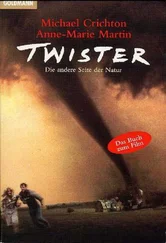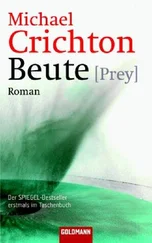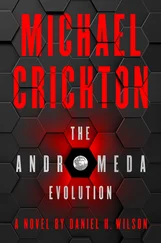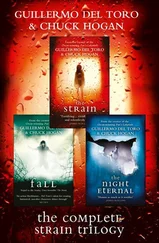Michael Crichton - The Andromeda Strain
Здесь есть возможность читать онлайн «Michael Crichton - The Andromeda Strain» весь текст электронной книги совершенно бесплатно (целиком полную версию без сокращений). В некоторых случаях можно слушать аудио, скачать через торрент в формате fb2 и присутствует краткое содержание. Жанр: Детская проза, на английском языке. Описание произведения, (предисловие) а так же отзывы посетителей доступны на портале библиотеки ЛибКат.
- Название:The Andromeda Strain
- Автор:
- Жанр:
- Год:неизвестен
- ISBN:нет данных
- Рейтинг книги:5 / 5. Голосов: 1
-
Избранное:Добавить в избранное
- Отзывы:
-
Ваша оценка:
- 100
- 1
- 2
- 3
- 4
- 5
The Andromeda Strain: краткое содержание, описание и аннотация
Предлагаем к чтению аннотацию, описание, краткое содержание или предисловие (зависит от того, что написал сам автор книги «The Andromeda Strain»). Если вы не нашли необходимую информацию о книге — напишите в комментариях, мы постараемся отыскать её.
The Andromeda Strain — читать онлайн бесплатно полную книгу (весь текст) целиком
Ниже представлен текст книги, разбитый по страницам. Система сохранения места последней прочитанной страницы, позволяет с удобством читать онлайн бесплатно книгу «The Andromeda Strain», без необходимости каждый раз заново искать на чём Вы остановились. Поставьте закладку, и сможете в любой момент перейти на страницу, на которой закончили чтение.
Интервал:
Закладка:
Perhaps the most significant thing about Stone was that he had done Nobel-caliber work as a law student, for it demonstrated the depth and range of his interests. A friend once said of him: "Jeremy knows everything, and is fascinated by I the rest." Already he was being compared to Einstein and to Bohr as a scientist with a conscience, an overview, an appreciation of the significance of events.
Physically, Stone was a thin, balding man with a prodigious memory that catalogued scientific facts and blue jokes with equal facility. But his most outstanding characteristic was a sense of impatience, the feeling he conveyed to every one around him that they were wasting his time. He had a bad habit of interrupting speakers and finishing conversations, a habit he tried to control with only limited success. His imperious manner, when added to the fact that he had won the Nobel Prize at an early age, as well as the scandals of his private life- he was four times married, twice to the wives of colleagues- did nothing to increase his popularity.
Yet it was Stone who, in the early 1960's, moved forward in government circles as one of the spokesmen for the new scientific establishment. He himself regarded this role with tolerant amusement- a vacuum eager to be filled with hot gas, " he once said- but in fact his influence was considerable.
By the early 1960's America had reluctantly come to realize that it possessed, as a nation, the most potent scientific complex in the history of the world. Eighty per cent of all scientific discoveries in the preceding three decades had been made by Americans. The United States had 75 per cent of the world's computers, and 90 per cent of the world's lasers. The United States had three and a half times as many scientists as the Soviet Union and spent three and a half times as much money on research; the U. S. had four times as many scientists as the European Economic Community and spent seven times as much on research. Most of this money came, directly or indirectly, from Congress, and Congress felt a great need for men to advise them on how to spend it.
During the 1950's, all the great advisers had been physicists: Teller and Oppenheimer and Bruckman and Weidner. But ten years later, with more money for biology and more concern for it, a new group emerged, led by DeBakey in Houston, Farmer in Boston, Heggerman in New York, and Stone in California.
Stone's prominence was attributable to many factors: the prestige of the Nobel Prize; his political contacts; his most recent wife, the daughter of Senator Thomas Wayne of Indiana; his legal training. All this combined to assure Stone's repeated appearance before confused Senate subcommittees- and gave him the power of any trusted adviser.
It was this same power that he used so successfully to implement the research and construction leading to Wildfire.
Stone was intrigued by Merrick's ideas, which paralleled certain concepts of his own. He explained these in a short paper entitled "Sterilization of Spacecraft," printed in Science and later reprinted in the British journal Nature. The argument stated that bacterial contamination was a two-edged sword, and that man must protect against both edges.
Previous to Stone's paper, most discussion of contamination dealt with the hazards to other planets of satellites and probes inadvertently carrying earth organisms. This problem was considered early in the American space effort; by 1959, NASA had set strict regulations for sterilization of earth origin probes.
The object of these regulations was to prevent contamination of other worlds. Clearly, if a probe were being sent to Mars or Venus to search for new life forms, it would defeat the purpose of the experiment for the probe to carry earth bacteria with it.
Stone considered the reverse situation. He stated that it was equally possible for extraterrestrial organisms to contaminate the earth via space probes. He noted that spacecraft that burned up in reentry presented no problem, but "live" returns- manned flights, and probes such as the Scoop satellites- were another matter entirely. Here, he said, the question of contamination was very great.
His paper created a brief flurry of interest but, as he later said, "nothing very spectacular." Therefore, in 1963 he began an informal seminar group that met twice monthly in Room 410, on the top floor of the University of California Medical School biochemistry wing, for lunch and discussion of the contamination problem. It was this group of five men: Stone and John Black of Berkeley, Samuel Holden and Terence Lisset of Stanford Med, and Andrew Weiss of Stanford biophysics- that eventually formed the early nucleus of the Wildfire Project. They presented a petition to the President in 1964, in a letter consciously patterned after the Einstein letter to Roosevelt, in 1940, concerning the atomic bomb.
University of California
Berkeley, Calif.
June 10, 1964
The President of the United States
The White House
1600 Pennsylvania Avenue
Washington, D.C.
Dear Mr. President:
Recent theoretical considerations suggest that sterilization procedures of returning space probes may be inadequate to guarantee sterile reentry to this planet's atmosphere. The consequence of this is the potential introduction of virulent organisms into the present terrestrial ecologic framework.
It is our belief that sterilization for reentry probes and manned capsules can never be wholly satisfactory. Our calculations suggest that even if capsules received sterilizing procedures in space, the probability of contamination would still remain one in ten thousand, and perhaps much more. These estimates are based upon organized life as we know it; other forms of life may be entirely resistant to our sterilizing methods.
We therefore urge the establishment of a facility designed to deal with an extraterrestrial life form, should one inadvertently be introduced to the earth. The purpose of this facility would be twofold: to limit dissemination of the life form, and to provide laboratories for its investigation and analysis, with a view to protecting earth life forms from its influence.
We recommend that such a facility be located in an uninhabited region of the United States; that it be constructed underground; that it incorporate all known isolation techniques; and that it be equipped with a nuclear device for self-destruction in the eventuality of an emergency. So far as we know, no form of life can survive the two million degrees of heat which accompany an atomic nuclear detonation.
Yours very truly,
Jeremy Stone
John Black
Samuel Holden
Terence Lisset
Andrew Weiss
Response to the letter was gratifyingly prompt. Twenty-four hours later, Stone received a call from one of the President's advisers, and the following day he flew to Washington to confer with the President and members of the National Security Council. Two weeks after that, he flew to Houston to discuss further plans with NASA officials.
Although Stone recalls one or two cracks about "the goddam penitentiary for bugs," most scientists he talked with regarded the project favorably. Within a month, Stone's informal team was hardened into an official committee to study problems of contamination and draw up recommendations.
This committee was put on the Defense Department's Advance Research Projects List and funded through the Defense Department. At that time, the ARPL was heavily invested in chemistry and physics- ion sprays, reversal duplication, pi-meson substrates- but there was growing interest in biologic problems. Thus one ARPL group was concerned with electronic pacing of brain function (a euphemism for mind control); a second had prepared a study of biosynergics, the future possible combinations of man and machines implanted inside the body; still another was evaluating Project Ozma, the search for extraterrestrial life conducted in 1961-4. A fourth group was engaged in preliminary design of a machine that would carry out all human functions and would be self-duplicating.
Читать дальшеИнтервал:
Закладка:
Похожие книги на «The Andromeda Strain»
Представляем Вашему вниманию похожие книги на «The Andromeda Strain» списком для выбора. Мы отобрали схожую по названию и смыслу литературу в надежде предоставить читателям больше вариантов отыскать новые, интересные, ещё непрочитанные произведения.
Обсуждение, отзывы о книге «The Andromeda Strain» и просто собственные мнения читателей. Оставьте ваши комментарии, напишите, что Вы думаете о произведении, его смысле или главных героях. Укажите что конкретно понравилось, а что нет, и почему Вы так считаете.









